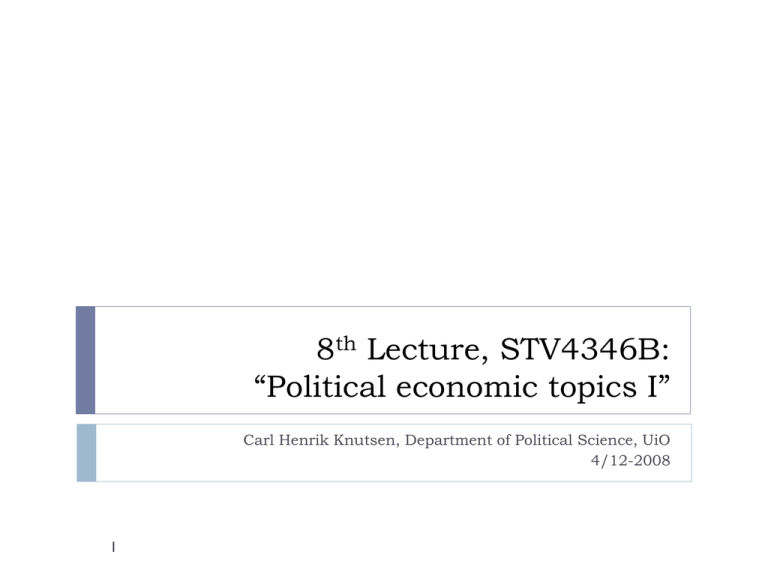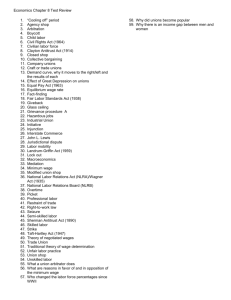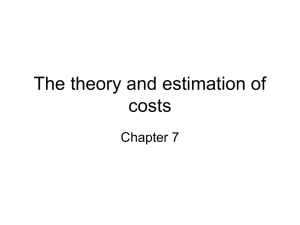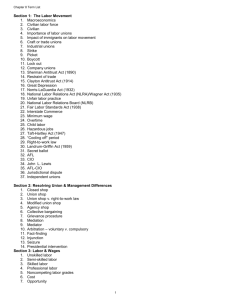8th Lecture, STV4346B: “Political economic topics I”
advertisement

8th Lecture, STV4346B:
“Political economic topics I”
Carl Henrik Knutsen, Department of Political Science, UiO
4/12-2008
1
Some introductory comments
We have now gone through parts I and II of the course
which focused on theoretical and methodological issues
(I) and some very general political economic topics (II). In
the third part, we will discuss some selected, more
focused topics.
To better illustrate the topics, and to enhance empirical
knowledge, the different topical lectures will draw on
experiences from within specified regions of the world.
This does not mean that the topics are only relevant for
the particular region with which it is presented, but the
issues might be extra salient in these regions.
2
Western Europe and North America
The richest regions of the world, capitalist systems
The most democratic regions of the world
Implication: developed economy and capitalist production
system, as well as a democratic polity as underlying
assumptions of studies
The more assumptions we can make, the more focused
our study will be, and the more specific the analysis and
its results.
Topics of the day: A) Varieties of capitalism, B) The
economic effects of labor market structures and “color”
of government, C) Economic voting
3
Varieties of Capitalism
Hall and Soskice Ch 1, only pages 1-51
Several forms of capitalism. Different countries have different
economic institutions, different business-firm relations and
different structures of firms
Differences in institutional framework Differences in corporate
strategy (rational response depends on context)
Institutional complementarity: The functioning/efficiency of one
particular institutional structure in one area depends on the
structure of institutions in other areas. Implications:
4
Institutions tend to come in packages
Institutional reform in one are alone is difficult
No “single best practice” in one area of the economy, independent of
context
Hall and Soskice cont’d
Focus is on variation in national political economies among
advanced capitalist nations
But: “Bringing the firm back in”. The importance of firm structures
and relations between firms and other actors
Strategic interaction as a central concept. How do economic actors
solve coordination problems? (Markets vs coordination)
The role of institutions in reducing uncertainty and allowing for credible
commitments:
The importance of informal rules, history and culture
5
1) How do firms exchange information?
2) How are firms monitored?
3) How are firms sanctioned when deviating from cooperation?
4) How do institutions provide opportunities for deliberation among firms?
Multiple equilibria. How do we arrive at one particular?
Contingencies and incomplete contracts: trust, norms and common culture as the
glue that makes cooperation possible
The basic ideal models: Coordinated and
Liberal market economies
Dimension
Coordinated
Liberal
Financial
system/market for
corporate
governance
Loans from bank,
Reputational loaning
Close relationship finance-production
Short term profitability less important
Stock market,
Many investors,
Short term profitability important
Industrial relations
Consensus decision making within firms
Employer-employee cooperation
Lasting employment contracts
Competitive labor markets Flexible
labor contracts
Education/training
systems
Specific skills
Firm- or industry specific provision of skills
General skills
Inter-firm relations
Joint projects
Formal and informal cooperation
Lax antitrust regulation
Market relationships,
Formal contracts
Strong antitrust regulation
Ideal-typical case
Germany
USA
6
Some examples of institutional
complementarities
Education and industrial organization:
Financial system and labor protection
Long term labor contracts and investment in specific skills; only when firm is relatively
certain that the worker will stay, is it profitable to invest in specific skills, and when firm
has invested in specific skills, profitable to keep existing labor
Bank loans with long time horizon enable firms to keep workers in recessions, less
possible if uses stock market (capital access depends on short term balance sheets). If
flexible labor markets, flexible capital markets might work better since resources
distributed to firms that are doing well, and new firms.
See pages 28 and 32 for the whole list of possible complementarities
A more general (but less convincing) theoretical argument:
Majoritarian democracy goes better together with a liberal market economy and
consensual democracy with coordinated market economy.
7
Strong government under majoritarianism producer groups cannot enter into cooperative
schemes with government.
Dominant governments and the problems of investing in specific assets (which are crucial in
coordinated economies, think specialization human capital for instance)
Some points..
Coordinated vs liberal as two poles on a dimension... Continuous spectrum
Different types of coordination: sectoral as in Germany vs large crosssectoral conglomerates as in Japan
Solving the coordination problem: markets, prices and contracts vs
negotiation, deliberation, repeated trade and reputation
Social policy and type of economy: Coordinated economies with specific
human capital and inflexible labor markets: need for social insurance since it
is very costly to lose job. Business’ role in constructing social policy
Comparative institutional advantage in terms of production sector and type
of innovation:
8
Liberal economies better at radical innovation (decentralization, lower barriers
to entry, flexible capital). Sectors argued to be fitting: biotechnology, ITC..
Coordinated economies better at incremental innovation (longer time horizons,
stability, specialized labor, networks and learning). Sectors argued to be fitting:
mechanical engineering, consumer durables
Some criticisms..
What is theory, what is description and what is evidence?
Observe Germany and US construct theoretical model argue that
the model is valid on the basis of evidence from Germany and US
If case is not fitting, like Japan, create new category (vertical
coordination)
How do we know when we are wrong?
Some claims seem to be made to fit the model: It is for example not
obvious why all the industries mentioned are either suited for
radical or incremental innovation (Where would you place the
movie industry? Why is aircraft manufacturing so different from
transport?)
Bottom line: This is as H&S themselves recognize the start of a
larger research project, and the criticisms are therefore a bit unfair.
However, important to read claims critically, and know that we are
dealing with an idealized model blended with empirical description.
9
Politics and economic growth (Scruggs)
How do labor market structures and color of
government affect economic growth?
The orthodox economic argument: decentralized labor
markets and small states better for growth
The heterodox argument: a positive role for government
and strong labor unions in facilitating growth
An everlasting political debate and many classical
theoretical arguments, but what do the data tell us?
10
Favorite quote by Stephen Colbert: “I am not constrained by
the data. I can believe whatever I want!”
Unions, wages and inflation
From macroeconomics: excessive wage demands result in inflation, which (perhaps)
hurts other aspects of the economy
Labor unions wage demands
Union A\Union B High wage
Low wage
High wage
(2,2)
(4,1)
Low wage
(1,4)
(3,3)
In this PD game, the equilibrium is {High wage, High wage}, but the unions would
have been better off (Pareto-improvement) coordinating at {low wage, low, wage}
The hump-shape thesis:
11
Countries with large, encompassing unions that internalize the externalities related to
excessive wage demands will have low inflation/good performance.
Countries with weak unions will also have low inflation due to little bargaining power.
Countries with medium-sized unions (sectorally divided for example) will have high
inflation
The interaction argument
Congruent regimes have higher growth/better
performance than incongruent regimes
left+strong unions & right+weak unions > left+weak & right+strong
The benefits of left+strong: social/class compromise
12
Only under system with social insurance and extensive public goods will
strong labor unions say goodbye to militancy and accept restraints on
wage demands
Earlier empirical studies: strong interaction effect between “color” of
government and strength of unions. Left+strong found to do equally well
as or better than right+weak. Both are better than incongruent regimes.
Empirical evidence, 74-84
13
Empirical evidence, 85-95
14
Scruggs’ results
Finds evidence of interaction effect
However, left+strong does equally well as right+weak from
mid-70s to mid-80s, and performs worse in the following
decade
Time and the structure of the economic environment: Do
Liberal economies do better than Social democrat/
coordinated economies in the new global economic
environment (globalization with fluid capital, rapid
technological change in decentralized information sector etc.)
?
Growth accounting indicates that even though left+strong are
not equally good as right+weak at technological change, they
are better at capital accumulation and increasing employment
15
Some methodological critiques of the study
Strange arguments for not using panel data evidence, uses
cross-section low n
Separation into decades: Are decades long enough to claim
systematic evidence on differences in growth rates?
16
Did Liberal economies increase their growth rates in 85-95, partly
because of the poor performance in previous years?
What about business cycles when using short time periods: It makes
a difference if a country begins the decade at the top of the business
cycle and ends at the bottom.
In any case: better to use PCSTS over the whole time period and
test for structural breaks (Chow-test).
Economic voting (Powell and Whitten)
Do voters vote with their pocket books?
Alternative explanations and complementarity:
Other factors also affect voting patterns; social cleavages and voting.
But some voters are susceptible to vote for different parties on the
basis of economic performance. Economic swing voters.
Earlier studies and a “puzzle”
Within-nation studies show that economic performance affect voting
patterns
Few robust findings from cross-national studies
The crudeness of aggregate tests: a need for specifications.
Variables of interest: Unemployment, inflation and economic
growth
17
Important considerations
Regressing (votest – votest-1) on economic performance is a
too crude investigation of the hypothesis that voters react to
economic performance
1) If government had a good election result in t-1 (it won power!),
there might be a natural adjustment in t, independent of
performance. It looks as if governments performing well do not
gain votes, but they actually do when compared to the real baseline
(t-1 overestimates baseline)
18
Additional point: gaining 2% of the electorate is more difficult if you
already have 98% of the electorate than if you have 50% control for size
in t-1
2) Performance might be evaluated by voters in terms of how well
other countries are doing No absolute measuring rods. 3%
inflation was a larger accomplishment in the 1970s than in the
1950s (or late 90s)
Important considerations cont’d
3) Left-wing governments might depend more on performance
related to unemployment and right wing government on
inflation. What do the core constituencies care about?
Remember that disgruntled voters can choose not to vote!
4) The policy context: The effects predicted to be larger in
countries that have political systems that clarify responsibility
for economic performance and thus generate political
accountability
19
Note: Link this argument back to Przeworski’s argument on the
effects of political accountability and retrospective voting on
incentives for politicians
Elaborations
Baseline model (replication of earlier study by Paldam) which
does not incorporate considerations 1-4, does generally not
find significant results for economic performance
Additional point not mentioned in study: The problem of multicolinearity: Especially GDP per capita and unemployment are highly
correlated Difficult to find significant effects.
Remedy for point 1: control for vote swing from t-2 to t-1
Remedy for point 2: use relative performance as independent
variables (relative to performance in other industrialized
countries at time t, pooled cross section time series approach
employed).
Remedy for point 3: Differentiate between right and left wing
governments in the analysis
20
The political context, remedies for point 4
Which governments are characterized by (more) clarity of
responsibility for economic outcomes? (relate to Persson and
Tabellini’s paper..)
General answer: those governments that are perceived to
have more unified control over policy making
Incentives for politicians to blur lines of responsibility, share blame
etc in bad times
Specific structures that reduce clarity of responsibility:
21
Lack of voting cohesion in government party or parties: weak,
undisciplined political parties
Participatory and inclusive committee system in legislature,
especially when committees are strong
Bicameral opposition (lack of majority in “second chamber”)
Minority government
Coalition governments
Remedies for point 4 cont’d
Constructs additive index ranging from 0 (New Zealand)
to 5 (Switzerland), where high value implies less clear
responsibility, and divides countries in analysis
Electoral rules and accountability: PR and the increased
chance of coalition government prediction: less
economic voting
Lijphart’s Consensual Democracies: less clarity of
responsibility because of various factors prediction: less
economic voting
22
Empirical results
23
Empirical conclusions
Economic voting significant only in countries with clear
political responsibility
In systems with clear responsibility
24
High relative GDP per capita growth positively affects votes for
incumbents
High relative unemployment negatively affect votes of left-wing
incumbents
High relative inflation negatively affects votes for right-wing
incumbents







